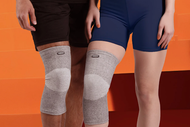Discover effective ways to reduce joint pain when lifting weights. Find exercises, nutrition tips, and more to ensure pain-free workouts!
Discover effective ways to reduce joint pain when lifting weights. Find exercises, nutrition tips, and more to ensure pain-free workouts!
Lifting weights is a fantastic way to stay fit and healthy, but it often comes with an unwelcome side effect: joint pains. Discovering effective ways to reduce joint pain when lifting weights can help you enjoy your workouts again pain-free.
The right strategies, complemented by a good understanding of how weightlifting affects your joints, will allow you to protect your body while reaching your fitness goals. Let's dive into it.
Weight training can help strengthen muscles, but it's strenuous for your joints. Here are eight ways to manage pain and prevent it from escalating into a full-on joint injury.
Use proper lifting techniques, including choosing the right weight and paying attention to your form.
Always warm up before workouts and cool down afterward.
Follow a balanced diet rich in anti-inflammatory foods.
Stay well-hydrated, especially during workouts.
Prioritize recovery and take regular rest days.
Use protective gear such as wrist wraps and knee sleeves.
Maintain regular physical activity and a healthy weight.
Seek professional help when needed.
Let's take a closer look at each of these ways so you can apply them to your strength training regimen.
Weightlifting is known for putting excessive pressure on your joints, especially your elbows, shoulders, and knees. Too much weight or strengthening exercises can cause injury and chronic joint pains like rheumatoid arthritis.
Lifting a weight too heavy for your current strength level strains your joints. Work on your form with lighter weights, and gradually increase the weight as your strength improves.
Good form involves engaging the right muscles and maintaining proper alignment during your lifts. Always prioritize form over lifting heavier weights.
The right form involves a neutral spine, engaged core, stable footing, and controlled movements, ensuring that the correct muscle groups are targeted while minimizing strain on the joints.
Warming up prepares your muscles and joints for the physical activity they're about to undertake. Dynamic stretches and light cardio can effectively increase your body temperature and improve flexibility.
Similar to warming up, cooling down involves light exercise and stretching to help your body transition back to a non-exercise state. It aids in reducing muscle stiffness, which can provoke joint pain.
A balanced diet rich in anti-inflammatory foods like fish, fruits, and vegetables can help alleviate joint pain. Strive to include any of these healthy foods on your meal plan:
Fatty Fish: Such as salmon, mackerel, tuna, and sardines.
Berries: Including strawberries, blueberries, and raspberries.
Green Leafy Vegetables: Spinach, kale, collards, and others.
Nuts: Almonds, walnuts, and others are packed with inflammation-fighting nutrients.
Olive Oil: A key component in a healthy, anti-inflammatory diet.
Tomatoes: High in antioxidants, particularly lycopene.
Turmeric: It contains curcumin, a powerful anti-inflammatory compound.
Cherries: Both sweet and tart cherries have been found to have anti-inflammatory properties.
Avocados: Packed with healthy fats, fiber, and anti-inflammatory compounds.
Dark Chocolate: Rich in antioxidants that reduce inflammation.
Dehydration can exacerbate joint pain. Ensure you're drinking enough water, especially before, during, and after workouts.
The recommended hydration amount can vary depending on multiple factors, such as the length and intensity of your workout, your body weight, and the climate.
As a general rule, the American Council on Exercise suggests drinking 17 to 20 ounces of water around 2 hours before exercising. Drink another 8 ounces as you warm up and 10 ounces every 10 to 20 minutes during exercise. Following your workout, aim to replenish with 8 ounces of water.
If you're exercising intensely or for a prolonged period, a sports drink may also be appropriate to replenish electrolytes.
Rest days are crucial for recovery and preventing joint pain. They allow your body to repair and strengthen itself between workouts.
It's recommended to take at least 48 hours of rest between intense training sessions for the same muscle group. This allows ample time for your muscles to recover, repair, and grow stronger. You can also switch workout routines for different muscle groups, allowing you to exercise on consecutive days while still giving rest to your different body parts.
Active recovery, such as light stretching or yoga, can improve blood flow and reduce muscle soreness and joint pain.
Protective gear during weight training is essential for ensuring safety and comfort while achieving your strength training goals. These two are essential must-haves:
Wrist Wraps: Wearing wrist wraps can provide additional support for your joints and reduce the risk of injury. Here's our collection of quality wrist wraps.
Knee Sleeves: Knee sleeves offer compression and support, which can help prevent knee pain when lifting weights. Here's an item we recommend for starters.
We recommend practicing regular physical activity that involves low-impact exercise like swimming or cycling, which can help keep your joints healthy.
Maintaining a healthy weight is also essential as it enhances your mobility and flexibility, improving your overall performance and ability to execute proper lifting forms.
Knowing the signs when you should consult a doctor can prevent major joint damage. Ask for medical attention if you experience severe or persistent joint pains that don't go away after rest and first-aid treatment.
Calling a physical therapist also gives you access to tailored exercises meant to strengthen your joints and alleviate pain, making weightlifting more comfortable and safer.
Lifting weights doesn't have to be a painful experience. With proper techniques, preparation, nutrition, and the right gear, you can keep doing what you love without the joint pain. Be proactive about protecting your joints and listen to your body's signals.
Ready to end your struggles with chronic muscular and joint pain? Thermo Recovery Wear can be your best companion both for recovery and injury prevention.

Incrediwear is on...
September 25, 24

Pain management i...
September 23, 24

Recovery wear is ...
September 12, 24